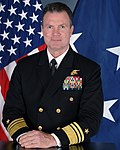Bureaucratic structure
Associate Deputy Director of Operations for Military Affairs (ADDO/MA)
This position 'faded off the org chart' after the creation of the ADCI/MS c. 1995 [2]
Associate Director of Central Intelligence for Military Support (ADCI/MS)
or Associate Director of Military Support [3]
or Assistant Director for Military Support [4]
and finally, Associate Director for Military Affairs
This position was created by CIA Director John Deutch in 1995 [5] He called it the 'Associate Director for Military Affairs' in a report in 1996, [6] but that name was not used until the late 1st decade of the 21st century in official documents, like org charts, and the 110th congress DoD appropriations bill says that Title IX Subtitle D will undergo changes "necessitated by the redesignation of the CIA's Assistant Director for Military Support as the Associate Director for Military Affairs." [7]
Office of Military Affairs
- 1992 - Created by CIA after problems during the Gulf War [8]
- 1995/1996 - Moved out of the Directorate of Operations by ADCI/MS Dennis C. Blair, to be directly under his office, which reported directly to the Director [9]
OMA is staffed by CIA and military personnel. As the agency's single POC for military support, OMA negotiates, coordinates, manages, and monitors all aspects of agency support for military operations. This support is a continuous process that can be enhanced or modified to respond to a crisis or developing operation. Interaction between OMA and the DCI representatives to the OSD, the Joint Staff, and the combatant commands facilitates the provision of national-level intelligence in support of joint operations, operation planning, and exercises. [10]
This page is based on this
Wikipedia article Text is available under the
CC BY-SA 4.0 license; additional terms may apply.
Images, videos and audio are available under their respective licenses.








